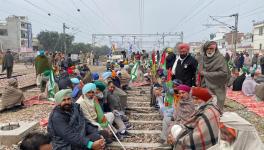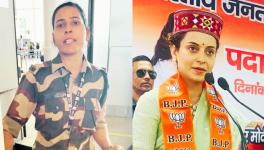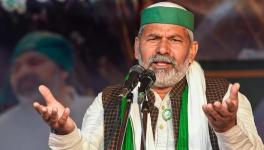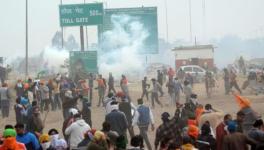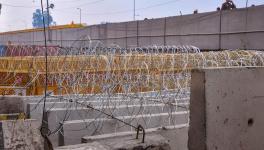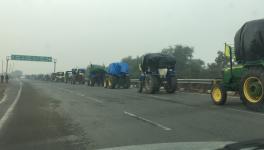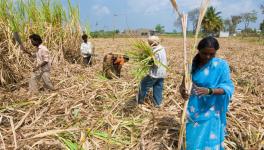Feminist Navsharan Singh on why State Fears Women Protesters in Farmer Movement
In the weeks before the tractor parade of 26 January, an important reason why the farmer movement caught the nation’s attention was the very visible participation of women in it. They came down from Punjab to Delhi, pitched camps for weeks to end, raised slogans, delivered speeches, organised community kitchens, and took part in cultural programmes. Some of them were photographed learning to drive tractors for the Republic Day parade, an eloquent symbol of their assertion. Was it an autonomous decision of women to join the sit-ins outside Delhi? Has Punjab’s agrarian crisis affected them in different ways than it has men? Do women in Punjab have a history of participating in protests?
To answer these questions, Newsclick turned to Navsharan Singh, who has worked with and written on women of rural Punjab. She was closely associated with Sexual Violence and Impunity in South Asia, a seven-volume project of Zubaan, a feminist publishing house. As the daughter of legendary playwright Gursharan Singh, who played a stellar role in taking theatre to rural Punjab, Singh has had a ringside view of how progressive cultural movement mobilised women to take part in the quest for change.
Did women participate in the tractor parade of 26 January? What was their reaction on how it ended?
Yes, they joined the rallies on the designated routes, in their tractors and trolleys. The night before 26 January was bitterly cold. Yet I found the women at the Tikri border [one of the three protest sites in Delhi] busy preparing for the rally. They repeatedly told me, ‘We have come to Delhi to get our rights. This is the message we want to convey through the rally.’ They had their woollens ready; they were planning to get up at 3 AM and make rotis for the journey. The division of work at the Morcha is that men cook vegetables, do the dishes—and women make rotis.
Then, on 26 January, a few women ‘found’ themselves in the Red Fort. I am a member of the team of Nation For Farmers, a group of concerned citizens, which has been gathering testimonies on the Red Fort incident. We now know from their testimonies that the police diverted them by barricading the routes the participants were to take for the return journey. They said they had wanted to stick to the designated routes. They were horrified to find themselves at the Red Fort. They said they tried calling their peers but the phones were not working. Since the internet had been disrupted, they could not use the route maps. They said they left their tractors and took autos to return to their camps.
They must have been deeply disappointed at how the tractor parade ended. Does that mood still persist?
On the evening of 26 January, they were undoubtedly disappointed. They took to exchanging notes among themselves at the protest sites. It was the experience of almost everyone that they had been led by the police to the Red Fort. Women were very angry with [singer-actor] Deep Sidhu and others who deviated from the designated route. ‘We need both brains and brawn to win this struggle,’ they said to me. On 28 January, when the Singhu protest site was attacked, women too were injured. Some of them have bandaged limbs, and they are unforgiving towards the government, nor have they been cowed down. They returned to the protest sites in even larger numbers.
We now know from farmers’ testimonies that the police diverted them by barricading the routes they were to take for the return journey. They said they had wanted to stick to the designated routes. They were horrified to find themselves at the Red Fort. They tried calling their peers but the phones and internet were not working. They said they left their tractors and took autos to return to their camps.
The women of west Uttar Pradesh have brought pitchers of water for [Uttar Pradesh’s Bharat Kisan Union leader] Rakesh Tikait, who is at the Ghazipur protest site. More women are reaching Singhu, particularly from Haryana. They have already restarted the community kitchens which were disrupted for three days. The women declared from the stage at Tikri that they were there to stay, and that the real fight begins now. Their quiet presence should send a message to the government.
The protest against the Citizenship Amendment Act (CAA), in 2019-2020, drew women from urban India, while the ongoing farmer agitation against the three new farm laws has had women from rural India participating in it. What has made women from two different backgrounds to come out to protest on two different issues?
Other than the rural-urban difference, most of the women who participated in the protest against the CAA at Delhi’s Shaheen Bagh, as also in other parts of the country, were first-time protesters. In the context of the new discriminatory citizenship law, which was opposed by a large number of people, the protesting women were also responding to the gendered idea of citizenship.
Women’s gendered experience of citizenship is evident in the public-private binary in the civic domain. This binary dictates that the public belongs to the male; the private to the female. In the anti-CAA protest, women protesters claimed the public—and also the Republic.
What do you mean by the gendered idea of citizenship?
Women experience differentiated citizenship rights. Their gendered experience of citizenship is evident in the public-private binary in the civic domain. This binary dictates that the public belongs to the male; the private to the female. In the anti-CAA protest, women protesters claimed the public—and also the Republic.
What made the anti-CAA women protesters to lay claim to the public?
Many of Shaheen Bagh’s women jumped into the protest because of what they had seen of the people’s experience during the exercise of preparing the National Register of Citizens in Assam. The terms for being included in the NRC were unambiguously laid out – it was through the possession of land, through lineage to families, and their presence in the state records.
We know women do not own land; the relationship of women with land is only through their labour. Their identity in families is transformed from being a daughter to daughter-in-law as they marry and move to another location, and they are hardly present in other state records. The NRC in Assam excluded a large number of women. This made them realise that their vulnerability was stark, in the sense that they, [because of gender and class position], could not possibly possess the documents required for proving their citizenship. This was why the slogan of “hum kagaz nahin dikhayenge” rolled out from protest sites.
What about the women in the farmer protest?
The women at Tikri and Singhu are not first-time protesters. Their participation is not so spontaneous. Women in Punjab have been mobilised for at least a decade, mostly by Left farmer unions. These women are from marginal and small landholding farming families. During the process of mobilisation, farmer unions have encountered the questions of women’s citizenship, their right to the public sphere, and their right to participate in popular struggles. They have engaged with these issues seriously. These questions have not been resolved. But these have been opened up for debate. Many farm unions have been marking March 8, the international women’s day, in a big way. They invite experts from outside and hold conventions in rural Punjab. One of the unions—the Bharatiya Kisan Union (Ekta Ugrahan)—has a slogan that says, ‘When women join a movement, the movement blooms.’
There is a school of thought that says farmer unions have brought women to Delhi for tactical reasons. Even the Chief Justice of India (CJI) remarked, “Why are women and elders kept in the protest?”
I have been watching Punjab’s women participate in the struggles for seven-eight years. The CJI’s comment is very unfortunate. I do not agree with those who say his statement is typical of the attitude of many men towards women. No, it is much deeper, about not accepting women’s claim to the public space. The same judiciary has rejected the bail pleas of women like Sudha Bhardwaj. The Supreme Court very well knows that anti-CAA women protesters like Gulfisha Fatima, Ishrat Jahan, Natasha Narwal and Devangana Kalita have been arrested under the draconian Unlawful Activities (Prevention) Act. The CJI’s concern over female participation in the farmer struggle does not square up.
Are you saying that the Supreme Court’s attitude toward women is more about denying them the right to the public sphere?
Yes. I strongly believe that they want 50 percent of India’s population to be locked up in their homes. That would leave the state to deal with the other 50 percent asserting their right to the public sphere.
Do the three laws affect women in very different ways than they do men?
The farmer movement is not just about the three laws. It has been building up amidst the prolonged agrarian crisis, which profoundly affects the farming families. Official data from Punjab show that between the years 2000 and 2015, around 17,000 farmers committed suicide. Some families have had more than one suicide. Many of the women from suicide families in Punjab came to Tikri last month. They carried the photographs of their loved ones, some women held two photographs, of husband and father or father-in-law, or husband and son, who had killed themselves. The effect of the agrarian crisis was writ large on their bodies. The men died and these women had to put food on the table and fend for their families, for instance, ensuring education for their children.
These women are trying to organise themselves, by establishing the Kisan Mazdoor Khudkushi Peedit Parivar Committee (KMKPPC), which sees farmer suicides as institutional murders. The KMKPPC was founded by Kiranjit Kaur, a young university student whose father had committed suicide. She has been going from village to village, collecting data on women whose husbands, sons, fathers or fathers-in-law committed suicide—and who are now destitute. The women’s experience of the agrarian crisis is far more intense.
You said the women of Punjab have been mobilised for 10-12 years. What was the trigger for the mobilisation?
Their mobilisation is connected with many aspects of Punjab’s Left legacy. Very significantly, Punjab has a very vibrant progressive cultural movement which can be traced back to the late 1960s. Today, there are scores of rural theatre troupes in Punjab, and we see them regularly at the sites in Delhi where farmers are protesting. Many of them are part of an umbrella organisation called the Punjab Lok Sabhyacharak Manch, which is committed to building a just society through a progressive cultural movement. These troupes do political theatre. Women are both part of the audience and also the lead performers.
The state wants fifty percent of India’s population to be locked up in their homes. That would leave the state to deal with the other fifty percent asserting their right to the public sphere.
Your father Gursharan Singh was the founder of the Punjab Lok Sabhyacharak Manch…
He and others established it together; Gursharan Singh was the founder-president. The Manch continues to have a very strong presence on the Punjab socialscape. One of Gursharan Singh’s lasting contributions is that he created a rural audience for theatre, giving a very safe space for women, both as audience and as performers. In fact, when he would see that women were not there in sufficient numbers, he would not let the performance to begin. He would go around the village and, like the pied piper, lead them to the venue. These performances were often about the everyday experiences of the poor and women. The plays focussed not just on the reality of women being raped, beaten or dispossessed, but had strong women protagonists. These also gave women the tools to understand their oppression.
Another very interesting tradition in Punjab is the all-night cultural programmes, a tradition which began during the years of militancy. There used to be night curfews in Punjab, from 9 pm to 5 am. Since people could not go out anyway, they would collect at 9 pm and watch cultural programmes all night. The tradition continued even after the militancy ebbed.
Do these plays engage with the agrarian crisis?
Yes, these plays seek to explain to women why their families are going bust, why they are unable to send their children to schools, and why there are no jobs for the youth. Dalit women learn why their daughters are not safe and their bodily autonomy not recognised. These performances were and are watched by large audiences, often in thousands.
Is the relationship between Jat Sikh women and Dalit women one of conflict?
Understanding this conflict and still building alliances have been a conscious political effort in Punjab. However, the scholarship on Dalit identity and assertion never observes Dalits forging alliances with the other oppressed. Dalit agency is confined to the assertion of Dalit identity, which is largely about Dalit masculinity.
In what sense?
The markers of Dalit assertion are seen in, say, the Dalit male youth proudly inscribing on their motorcycles, “Son of a chamar.” This is celebrated as the arrival of the Dalit man, who was emasculated by centuries of caste discrimination, and who is now standing up to the Jat Sikh with his twirled up moustache. But his assertion is downright masculine. Dalit women are unable to break into this construction of Dalit identity and assertion, let alone the other oppressed.
What is unique to the experience of Dalit women compared with Dalit men?
Dalit women face the triple oppression of caste, class, and gender. The vulnerability of Dalit women is even more than that of Dalit men because of the sexual violence they experience. Their right to sexual safety and bodily autonomy is subverted all the time.
Essentially, this tension arises from the fact that Jat Sikhs force themselves on Dalit women as a matter of entitlement?
Yes, but it is changing now and being challenged. That is why you see more violence against Dalits and more violent rapes.
Dalit agency, celebrated as the arrival of the Dalit man standing up to the Jat Sikh with his twirled up moustache, is largely about Dalit masculinity. Dalit women are still unable to break into this construction of Dalit identity and assertion.
Do Jat Sikh women join protests held against rapes involving Dalit women?
We have seen a few powerful examples in recent years. To cite just two, they joined the 2014 protest against the rape of a Dalit minor in Gandhar village, Muktsar district. They again did so in 2012, against what is known as the Shruti rape case. In all such protests, women came out to protest as women, cutting across the caste divide. Farmer union leaders and farm labour unions [which largely comprise Dalits] tried to forge cross-caste alliances by demonstrating who the oppressor was; that if they were to come together, they could fight the oppressor better.
Are cross-caste alliances confined to just protesting against the sexual violence?
These have been forged on other issue as well. A few years ago, the Malwa region’s cotton crop was hit by the whitefly for three consecutive years. Farmers were ruined; they accumulated heavy debts. Those years saw a large number of suicides by farmers and farm labourers. Under pressure from farmer unions, the Punjab government decided to pay compensation to cotton-growers. But then came the issue of farm labourers, a large number of whom were women. They said they too had lost seasons of employment. After all, if there were no cotton to pick, how would they get employed? This was a battle that landowning farmers and Dalit labourers fought together. Farm unions were able to get compensation for labourers. Likewise, in October 2010, the Punjab government acquired 806 acres of land in Gobindpura village, in Mansa district, farmer and labour unions waged a joint struggle to get compensation for Dalit labourers.
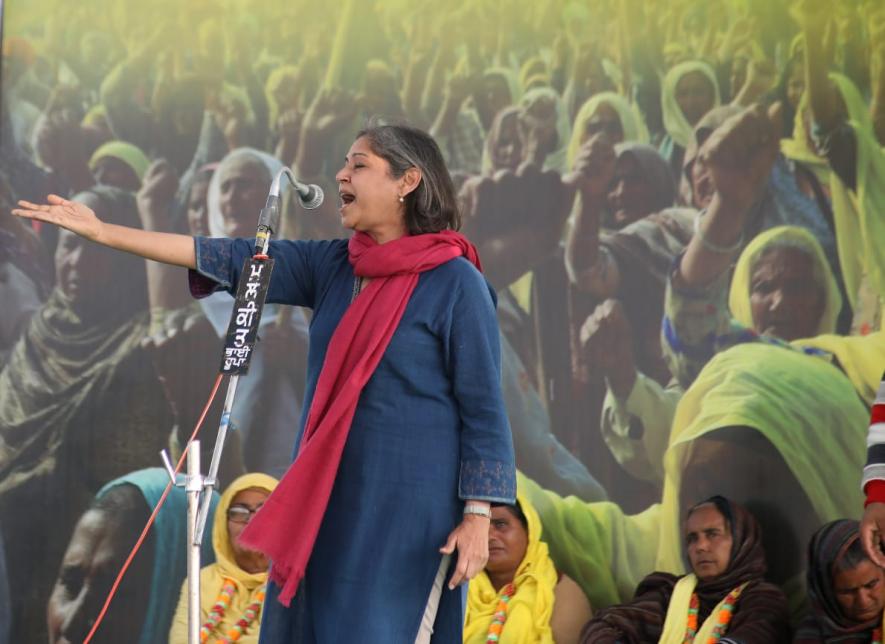
Any example where Dalit women were at the forefront of a protest movement?
The Punjab Village Commons Land (Regulation) Act, 1961 allows panchayats to lease village land to the highest bidder on the condition that a third would be reserved for the Scheduled Castes and auctioned separately on a lower price. Jat-Sikh landowners have been subverting the process by bidding in the name of Dalits or through proxy candidates. In 2014, young Dalit women of Matoi village, Sangrur district, stormed one such proxy auction and demanded a fair process to be installed. They were badly beaten up. But they stood their ground and demanded their share of the land. The women then said that they wanted land for livelihood—and also because they did not want to be humiliated when they went out to get fodder for animals or to relieve themselves. Open defecation is still very much prominent in prosperous Punjab, largely because the poor don’t have toilets at home.
Today in over 100 villages, under the banner of Zameen Prapti Sangharsh Samiti, Dalits have been bidding and acquiring one-third panchayati land. In many villages, they are doing cooperative farming. Dalit women have been at the forefront of these struggles.
What is the attitude of Jat women towards Dalit women?
Jat Sikh women are not homogenous. Those who belong to families categorised as small and marginal farmers do sometimes see themselves as the allies of Dalits. But caste remains a divider than a unifier.
Get the latest reports & analysis with people's perspective on Protests, movements & deep analytical videos, discussions of the current affairs in your Telegram app. Subscribe to NewsClick's Telegram channel & get Real-Time updates on stories, as they get published on our website.









